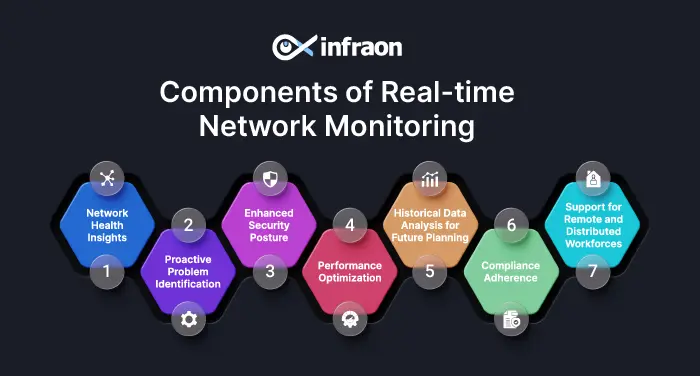Real-time network monitoring is an integral part of modern network management, offering a wide array of capabilities and benefits to ensure network integrity and performance. This dynamic approach encompasses the continual gathering and examination of data from a multitude of sources, such as network traffic, system logs, and performance metrics, providing a real-time overview of the network’s condition.
Related blog: 5 Key Features to Look for in Network Monitoring Software
Components of real-time network monitoring

- Network health insights: Real-time network monitoring provides a live feed of the network’s status, allowing for the immediate identification of any issues that may arise.
- Proactive problem identification: Unlike traditional monitoring methods that may only report problems after they’ve occurred, real-time monitoring proactively identifies issues as they develop.
- Enhanced security posture: By continuously analyzing network traffic for suspicious activities, real-time monitoring strengthens an organization’s security posture.
- Performance optimization: Real-time data analysis helps in pinpointing inefficiencies and bottlenecks within the network by understanding traffic flows and usage patterns.
- Historical data analysis for future planning: While the focus is on real-time data, historical data is also stored – enabling trend analysis and capacity planning.
- Compliance adherence: Real-time network monitoring ensures that the network adheres to industry standards and policies.
- Support for remote and distributed workforces: Real-time network monitoring ensures connectivity and access to resources are maintained at all times, supporting productivity regardless of location.
What are the most popular performance monitoring metrics?
- Bandwidth measurement: This metric evaluates the volume of data transmitted through the network at a specific moment. It helps companies determine potential congestion points and verify the network’s capacity to handle expected data loads.
- Transmission delay: This metric reflects the duration required for data packets to travel from one point in the network to another. Elevated transmission delays can indicate issues like network congestion or faulty network components needing attention.
- Transmission error rate: This figure represents the frequency of errors occurring during data transmission across the network. A higher rate of errors could suggest problems with network hardware or signal integrity.
- Data throughput: This value measures the total amount of data that successfully passes through the network over a set period.
- Traffic analysis protocols: These protocols are utilized for collecting detailed data on network traffic, including the origin and destination of IP addresses, port numbers, and the types of protocols in use.
- Network management protocol metrics (SNMP): This involves utilizing network management protocols to facilitate streamlined communication and collaboration among teams, enhancing the management and resolution of network issues.
Overcoming IM challenges with real-time network monitoring
Prompt issue resolution to reduce downtime
Downtime can be costly for any organization, impacting revenue, customer trust and business reputation. Real-time network monitoring enables the discovery and resolution of issues as they arise, minimizing the duration and impact of network downtime. This prompt response capability ensures that services remain available and operational, maintaining business continuity.
Preserving network health and security
The health and security of a network are paramount for maintaining operational integrity. Real-time monitoring provides a continuous assessment of network conditions, detecting anomalies that could indicate security threats or performance issues. By identifying these risks early, organizations can implement corrective measures to preserve the network’s overall health and safeguard against vulnerabilities.
Addressing security risks and data breaches
Real-time network monitoring offers a proactive defense mechanism against malware infections, unauthorized access attempts, and other security breaches. By continuously analyzing traffic and behavior patterns, it can detect unusual activity that may signify a security threat, enabling a swift response to prevent data breaches.
Gaining insights for optimization and improvement
Beyond troubleshooting and security, real-time network monitoring provides valuable insights into network usage, performance, and security posture. This intelligence allows IT teams to understand how the network is utilized and identify areas for optimization and improvement.
Real-time alerts for proactive management
Alerts and notifications about potential issues offer a huge advantage of real-time network monitoring. This feature ensures that administrators are immediately informed of problems, allowing for rapid response to prevent or mitigate impact. Whether it’s an emerging security threat or a performance bottleneck, real-time alerts empower IT teams to maintain control over the network environment.
Cost savings through preventative measures
Finally, the implementation of real-time network monitoring can lead to substantial cost savings. By preventing downtime, optimizing network performance, and averting security incidents, organizations can avoid the expenses associated with network failures, lost productivity, and data breaches.
The proactive nature of real-time monitoring means that issues can be addressed before they turn into costly problems.
Related blog: Network Monitoring System and All You Need to Know in 2024
Conclusion
Embracing real-time network monitoring is akin to setting the sails correctly on a ship navigating through unpredictable seas. It equips organizations with the foresight, agility, and strategic edge necessary to thrive. As the ITOps world moves forward, the integration of real-time network monitoring is already a fundamental component that defines the resilience, dynamism, and success of future enterprises.



















